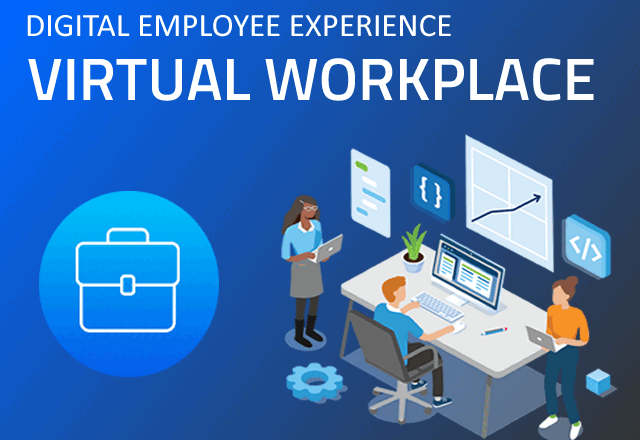
In the modern business landscape, the digital employee experience (DEX) and virtual workplace solutions have become essential for small businesses aiming to stay competitive and agile. These innovations not only enhance productivity but also improve employee satisfaction and retention. Let's delve into the key benefits of embracing digital employee experience and virtual workplace solutions.
1. Increased Flexibility and Work-Life Balance
One of the most significant advantages of virtual workplace solutions is the flexibility they offer. Employees can work from anywhere, at any time, which helps them achieve a better work-life balance. This flexibility is particularly beneficial for small businesses, as it can lead to higher job satisfaction and reduced turnover rates.
Example: A small marketing agency allows its employees to work remotely, enabling a graphic designer to balance work with personal commitments, leading to increased job satisfaction and creativity.
2. Enhanced Collaboration and Communication
Digital tools and platforms facilitate seamless communication and collaboration among team members, regardless of their physical location. Solutions like video conferencing, instant messaging, and project management software enable employees to work together efficiently, share ideas, and stay connected. This enhanced collaboration can lead to more innovative solutions and faster problem-solving.
Example: A software development team uses a project management tool like Trello to track progress, assign tasks, and collaborate on code, resulting in faster project completion and fewer misunderstandings.
3. Cost Savings
Implementing virtual workplace solutions can result in significant cost savings for small businesses. By reducing the need for physical office space, utilities, and other overhead expenses, businesses can allocate resources more effectively. Additionally, digital tools often come with scalable pricing models, allowing small businesses to pay only for what they need.
Example: A small consulting firm transitions to a fully remote model, saving on office rent and utilities, and reinvesting those savings into employee development and marketing efforts.
4. Access to a Global Talent Pool
Virtual workplace solutions break down geographical barriers, enabling small businesses to tap into a global talent pool. This access to diverse skills and perspectives can drive innovation and growth. Small businesses can hire the best talent, regardless of location, and create a more dynamic and competitive workforce.
Example: A tech startup hires a talented developer from another country, bringing unique skills and perspectives to the team, which helps in developing a cutting-edge product.
5. Improved Employee Engagement and Productivity
A positive digital employee experience can lead to higher levels of engagement and productivity. When employees have access to the right tools and resources, they can perform their tasks more efficiently and with greater satisfaction. Features like user-friendly interfaces, personalized dashboards, and integrated workflows contribute to a smoother and more enjoyable work experience.
Example: An e-commerce company implements a user-friendly intranet that centralizes all resources and tools, making it easier for employees to find information and complete tasks quickly.
6. Scalability and Agility
Digital workplace solutions offer scalability, allowing small businesses to adapt quickly to changing needs and market conditions. Whether it's onboarding new employees, expanding operations, or adjusting to remote work trends, these solutions provide the flexibility to scale up or down as required. This agility is crucial for small businesses looking to stay competitive in a rapidly evolving market.
Example: A small online retailer experiences a surge in orders during the holiday season and quickly scales up its customer support team using virtual workplace solutions to handle the increased demand.
7. Enhanced Security and Compliance
With the rise of remote work, ensuring data security and compliance has become more critical than ever. Virtual workplace solutions often come with robust security features, such as encryption, multi-factor authentication, and regular updates, to protect sensitive information. Additionally, these solutions help small businesses comply with industry regulations and standards, reducing the risk of data breaches and legal issues.
Example: A healthcare provider uses a secure virtual desktop infrastructure (VDI) to ensure patient data is protected and complies with HIPAA regulations, even when accessed remotely.
8. Better Employee Well-Being
A well-designed digital employee experience can contribute to better overall well-being. By providing tools that support mental health, such as wellness apps and virtual counseling services, small businesses can show their commitment to employee well-being. This support can lead to a healthier, more motivated workforce.
Example: A small financial services firm offers virtual wellness programs and access to mental health resources, helping employees manage stress and maintain a healthy work-life balance.
Conclusion
Embracing digital employee experience and virtual workplace solutions offers numerous benefits for small businesses. From increased flexibility and cost savings to enhanced collaboration and security, these innovations can drive growth and success. By investing in the right digital tools and creating a positive virtual work environment, small businesses can empower their employees and thrive in the digital age.
—
Want to learn more about Digital EX and Virtual Workplace Solutions? Get in touch with FUSION 1 today!


